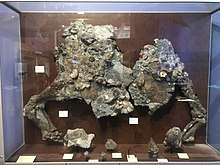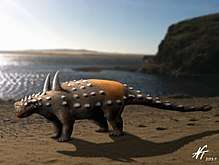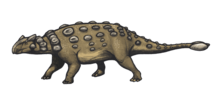Aletopelta
Aletopelta coombsi /əˌliːtoʊˈpɛltə ˈkoʊmzi/ is an herbivorous ankylosaurian ornithischian dinosaur that during the Late Cretaceous lived in the area of what is now Southern California.
| Aletopelta | |
|---|---|
 | |
| Holotype | |
| Scientific classification | |
| Kingdom: | Animalia |
| Phylum: | Chordata |
| Clade: | Dinosauria |
| Order: | †Ornithischia |
| Suborder: | †Ankylosauria |
| Family: | †Ankylosauridae |
| Genus: | †Aletopelta Ford & Kirkland, 2001 |
| Species: | †A. coombsi |
| Binomial name | |
| †Aletopelta coombsi Ford & Kirkland, 2001 | |
Discovery and naming
In 1987, construction work was done on the College Boulevard near Carlsbad at the Californian coast. In the Letterbox Canyon between El Camino Real and Palomar Airport Road, northwest of McClellan–Palomar Airport, the road was widened. While paleontologically surveying the work, Bradford Riney noted that a skeleton had been uncovered by a ditch dug for a sewage pipe. Within days, it was secured by the San Diego Natural History Museum. In 1988, the find was reported by Thomas Deméré. The discovery drew much attention because it was the first important ankylosaurian fossil known from the area. It was dubbed the "Carlsbad Ankylosaur". In 1996, the fossil was described but not named by Deméré and Walter Preston Coombs.[1]
In 2001, the type species Aletopelta coombsi was named by Tracy Lee Ford and James Kirkland. Etymologically, the generic name is composed of the Greek terms ἀλήτης, aletes, and πέλτη, pelte, meaning respectively "wanderer" and "small shield". This genus name was suggested by Ben Creisler because the fossil location, at the time the dinosaur died, being located on the tectonic plate containing the Peninsular Ranges Terrane, was somewhere opposite the middle of Mexico. This plate had thus been wandering northward since, carrying the specimen with it. The specific epithet honors the vertebrate paleontologist Walter Preston Coombs, Jr., "for his ground-breaking work on ankylosaurs and his years of research, which have inspired many an enthusiast as well as professional paleontologist".[2]
Fossils

Aletopelta is known from a single partial skeleton lacking the skull, holotype SDNHM 33909, part of the collection of the San Diego Natural History Museum, San Diego, California. The skeleton including femora (the thighbones), tibiae (shinbones), fibulae (calf bones) and incomplete parts of a scapula (shoulder blade), humerus, ulna, left and right ischium, vertebrae, ribs, partial armor over the pelvic girdle, a cervical halfring plus at least sixty detached armor plates and eight teeth was found in a layer of the Late Cretaceous (Upper Campanian) marine Point Loma Formation, dating from the late Campanian, in 2001 estimated at 75.5 million years old.[2] Apparently, the animal's bloated carcass floated out to sea, and formed a miniature reef environment after it sank to the bottom, landing on its back, as testified by Pelecypoda attaching to the bones. The remains were possibly scavenged by sharks. Most long bones have lost their joint surfaces and were hollowed out. As a result, the condition of the skeletal elements is poor.[1]
Description
Aletopelta is a medium-sized ankylosaurid, originally estimated to be around 6 metres (20 ft) long. In 2010, Gregory S. Paul estimated its length at five metres, its weight at two tonnes.[3]
Due to the damaged state of the holotype bones, it is difficult to determine distinguishing traits. In 2004, Matthew Vickaryous e.a. therefore considered Aletopelta to be a nomen dubium.[4]
Phylogeny
Aletopelta is diagnosed as an ankylosaurid mainly based on the shape and arrangement of its osteoderm armor, which is closer in form to ankylosaurids than to nodosaurids.
See also
References
- W.P. Coombs, Jr. and T.A. Deméré, 1996, "A Late Cretaceous nodosaurid ankylosaur (Dinosauria: Ornithischia) from marine sediments of coastal California", Journal of Paleontology 70(2): 311-326
- T.L. Ford and J.I. Kirkland, 2001, "Carlsbad ankylosaur (Ornithischia, Ankylosauria): an ankylosaurid and not a nodosaurid", In: The Armored Dinosaurs. Indiana University Press, Bloomington pp 239-260
- Paul, G.S., 2010, The Princeton Field Guide to Dinosaurs, Princeton University Press p. 233
- Vickaryous, M.K.; Maryańska, T. & Weishampel, D.B. (2004). "Ankylosauria". In Weishampel, D. B.; Dodson, P. & Osmólska, H. (eds.). The Dinosauria (Second Edition). University of California Press. pp. 363–392. ISBN 0-520-24209-2.

